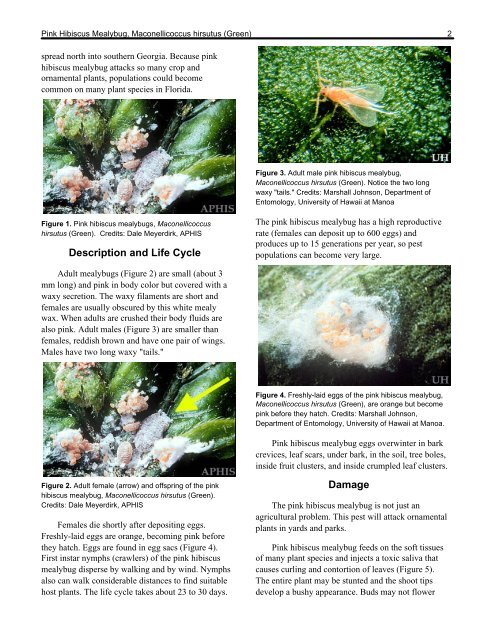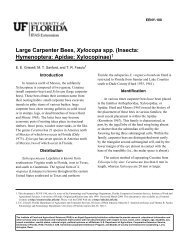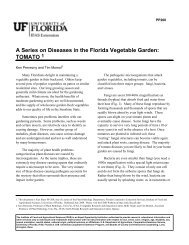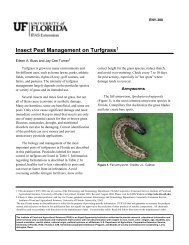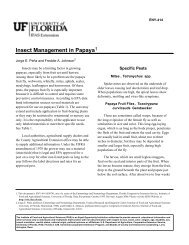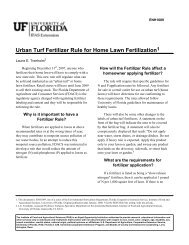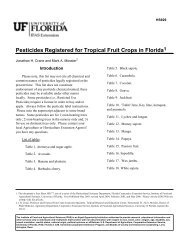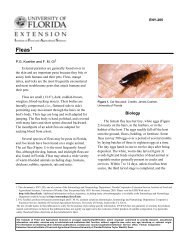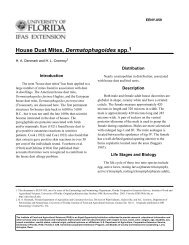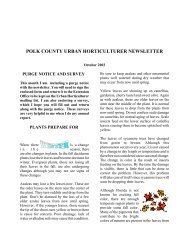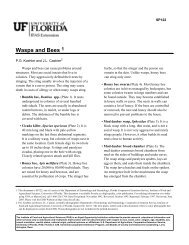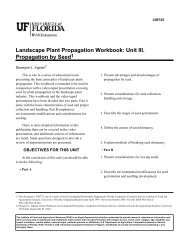Pink Hibiscus Mealybug, Maconellicoccus hirsutus - Polk County ...
Pink Hibiscus Mealybug, Maconellicoccus hirsutus - Polk County ...
Pink Hibiscus Mealybug, Maconellicoccus hirsutus - Polk County ...
You also want an ePaper? Increase the reach of your titles
YUMPU automatically turns print PDFs into web optimized ePapers that Google loves.
<strong>Pink</strong> <strong>Hibiscus</strong> <strong>Mealybug</strong>, <strong>Maconellicoccus</strong> <strong>hirsutus</strong> (Green) 2<br />
spread north into southern Georgia. Because pink<br />
hibiscus mealybug attacks so many crop and<br />
ornamental plants, populations could become<br />
common on many plant species in Florida.<br />
Figure 3. Adult male pink hibiscus mealybug,<br />
<strong>Maconellicoccus</strong> <strong>hirsutus</strong> (Green). Notice the two long<br />
waxy "tails." Credits: Marshall Johnson, Department of<br />
Entomology, University of Hawaii at Manoa<br />
Figure 1. <strong>Pink</strong> hibiscus mealybugs, <strong>Maconellicoccus</strong><br />
<strong>hirsutus</strong> (Green). Credits: Dale Meyerdirk, APHIS<br />
Description and Life Cycle<br />
The pink hibiscus mealybug has a high reproductive<br />
rate (females can deposit up to 600 eggs) and<br />
produces up to 15 generations per year, so pest<br />
populations can become very large.<br />
Adult mealybugs (Figure 2) are small (about 3<br />
mm long) and pink in body color but covered with a<br />
waxy secretion. The waxy filaments are short and<br />
females are usually obscured by this white mealy<br />
wax. When adults are crushed their body fluids are<br />
also pink. Adult males (Figure 3) are smaller than<br />
females, reddish brown and have one pair of wings.<br />
Males have two long waxy "tails."<br />
Figure 4. Freshly-laid eggs of the pink hibiscus mealybug,<br />
<strong>Maconellicoccus</strong> <strong>hirsutus</strong> (Green), are orange but become<br />
pink before they hatch. Credits: Marshall Johnson,<br />
Department of Entomology, University of Hawaii at Manoa.<br />
<strong>Pink</strong> hibiscus mealybug eggs overwinter in bark<br />
crevices, leaf scars, under bark, in the soil, tree boles,<br />
inside fruit clusters, and inside crumpled leaf clusters.<br />
Figure 2. Adult female (arrow) and offspring of the pink<br />
hibiscus mealybug, <strong>Maconellicoccus</strong> <strong>hirsutus</strong> (Green).<br />
Credits: Dale Meyerdirk, APHIS<br />
Females die shortly after depositing eggs.<br />
Freshly-laid eggs are orange, becoming pink before<br />
they hatch. Eggs are found in egg sacs (Figure 4).<br />
First instar nymphs (crawlers) of the pink hibiscus<br />
mealybug disperse by walking and by wind. Nymphs<br />
also can walk considerable distances to find suitable<br />
host plants. The life cycle takes about 23 to 30 days.<br />
Damage<br />
The pink hibiscus mealybug is not just an<br />
agricultural problem. This pest will attack ornamental<br />
plants in yards and parks.<br />
<strong>Pink</strong> hibiscus mealybug feeds on the soft tissues<br />
of many plant species and injects a toxic saliva that<br />
causes curling and contortion of leaves (Figure 5).<br />
The entire plant may be stunted and the shoot tips<br />
develop a bushy appearance. Buds may not flower


